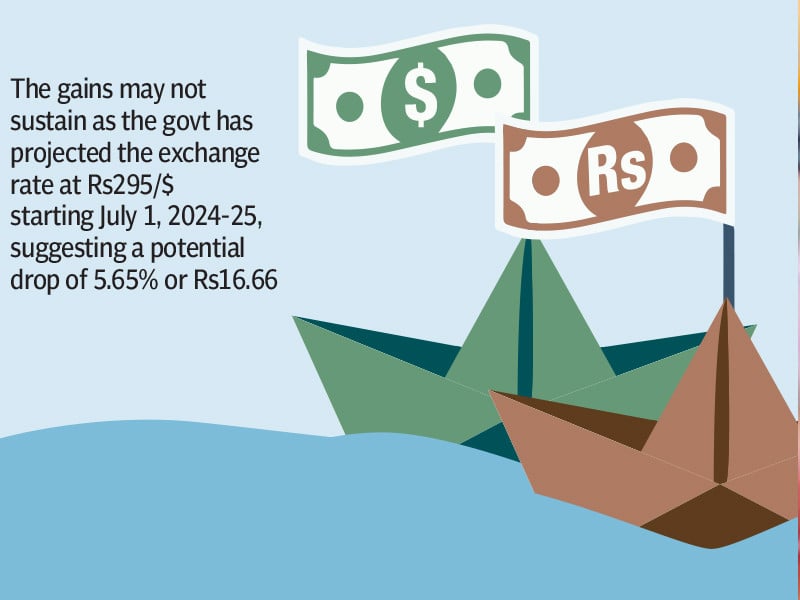
The Pakistani currency appreciated by 2.75% (or Rs7.65) in the outgoing fiscal year 2023-24, closing at Rs278.34 against the US dollar in the inter-bank market on Friday. This marks the first appreciation after a three-year decline, ending the currency’s losing streak. However, the gains may not sustain, as the government has projected the exchange rate at Rs295/$ for the next fiscal year starting July 1, 2024-25, suggesting a potential drop of 5.65% or Rs16.66.
According to State Bank of Pakistan’s (SBP) data, the currency increased by Rs0.03/$ on Friday, the last working day of FY24, maintaining an uptrend for the fourth consecutive working day. To recall, the rupee hit a high of Rs277.03/$ in March 2024 and a low of Rs307.10/$ in September 2023.
In a brief commentary, Tahir Abbas, Head of Research at Arif Habib Limited, attributed the year-on-year appreciation of 2.75% to a decrease in the current account deficit, improved foreign inflows, a reduction in the spread between open and inter-bank rates, and other administrative measures. At the start of the year, the rupee was highly volatile due to extreme political uncertainty and uncontrolled smuggling of foreign currencies to neighbouring countries, including Afghanistan and Iran.
The rupee lost 6.87% or Rs21.10 in the first two months of FY24, hitting a record low of Rs307.10/$ in the first week of September 2023, but closed the FY2023 at Rs286/$. The sinking rupee was pressured by dwindling foreign exchange reserves as black marketers smuggled dollars to Afghanistan, which needed foreign currency after the US blocked its reserves in Western banks following the Taliban’s return to power.
Political stability improved in Pakistan after the completion of the previous government’s term in August 2023 and the establishment of a caretaker government. The caretaker government launched a crackdown on currency smugglers and illegal currency markets, stabilising the rupee-dollar exchange rate. Administrative measures, International Monetary Fund (IMF) loan tranches, funds from friendly countries, and control over imports helped the rupee partially recover, making a historical gain of about 10.50% or Rs29 from September 2023 to March 2024, ending the year at a high of Rs277.03/$.
The successful completion of the first and second reviews of the economy by the IMF under the-then $3 billion loan programme, along with subsequent loan tranches and bilateral inflows, boosted foreign exchange reserves to over $9 billion in the fourth quarter of FY24 from less than $4 billion at the end of FY23. The rise in reserves supported the rupee, which has remained stable for the past couple of months at around the current levels.
Cuts in imports, improved exports, and a surge in workers’ remittances also helped build foreign exchange reserves, supporting the rupee. The reserves remained stable at around $9 billion until mid-June, despite the government making massive repayments on foreign debt and interest payments throughout the year. The central bank also purchased significant amounts of dollars from local markets to bolster the foreign exchange reserves amid a surplus supply of foreign currency and muted import demand.
Rupee-Dollar parity outlook
The government has projected the rupee-dollar parity at Rs295/$ for FY25, while the IMF assumes it at Rs329/$. Financial experts believe the next IMF loan programme will provide a financial cushion, allowing the government to slightly increase imports and improve economic activities. However, foreign debt repayments of around $24-25 billion in the next year will pressure the rupee. Moderate growth in imports is likely to widen the current account deficit in FY25, mounting pressure on the rupee. Efforts to ramp up exports and workers’ remittances will help manage the current account deficit.




1730752226-0/Untitled-design-(35)1730752226-0-165x106.webp)











1730706072-0/Copy-of-Untitled-(2)1730706072-0-270x192.webp)
COMMENTS
Comments are moderated and generally will be posted if they are on-topic and not abusive.
For more information, please see our Comments FAQ